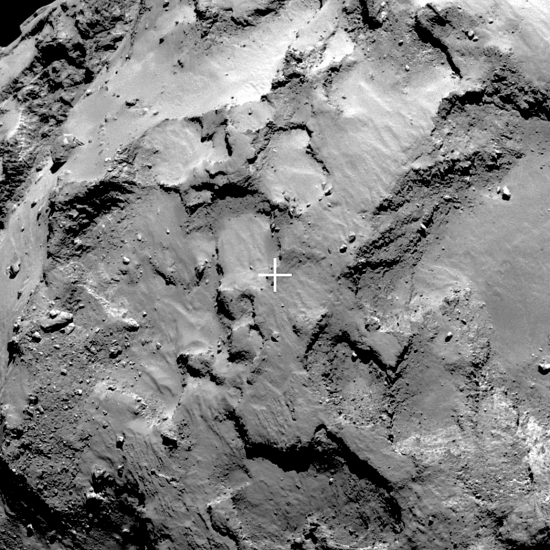
The landing site chosen for Philae. Credit: ESA/Rosetta/MPS for OSIRIS Team MPS/UPD/LAM/IAA/SSO/INTA/UPM/DASP/IDA
Sep 17, 2014
The Philae landing site is now confirmed.
Look closely at the above image. It appears to be a rocky plain, with pits and ridges, covered in dust and scattered boulders. An ariel view of the American desert Southwest would closely match the terrain. However, this image is of Comet 67P/Churyumov-Gerasimenko’s surface, an environment that is supposed to be covered with ice and frost, or at least something that looks frozen. Instead, it appears dessicated, without any evidence of freezing.
Comet 67P/C-G conforms to what was discovered in the past. Comets possess black, burned nuclei; craters and rocky landscapes instead of ice fields; narrow, energetic jets; ion tails pointing away from the Sun; sulfur compounds that require high temperatures to form; and an abundance of ultra-fine dust. Those characteristics point to electricity as their common source. Most important of all, water vapor is more prevalent farther away from cometary nuclei than close in—diametrically opposed to what should be found if water ice and frost drive cometary jets.
Comets travel through a differential electric potential as they move toward the Sun. The variable electric fields cause visible glow discharges, similar to what is found when a neon lamp is energized. Rather than frigid, frangible denizens of a hypothetical deep space repository called the Oort Cloud, which are ejected and thrown toward the inner Solar System by gravitational influences, comets are electrically active, solid bodies. They form plasma sheaths that can become comas, often more than a million kilometers in diameter. Plasma filaments connect comets with the Sun’s electric field, generating “hot spots” on their surfaces. So hot that extreme ultraviolet light and X-rays were detected radiating from comet Hyakutake.
According to Electric Universe advocate, Wal Thornhill: “The electric field near the comet nucleus is expected if a comet is a highly negatively charged body, relative to the solar wind…So the presence of negative oxygen and other ions close to the comet nucleus is to be expected. Negative oxygen ions will be accelerated away from the comet in the cathode jets and combine with protons from the solar wind to form the observed OH radical at some distance from the nucleus. The important point is that the OH does not need to come from water ice on, or in, the comet.”
Comets, specifically, have nothing to do with an ancient nebular cloud of cold gas and dust that became gravitationally unstable and collapsed into the Solar System of today. Comets and their asteroid sisters are relative newcomers to the solar family and might have been blasted out of larger bodies by tremendously powerful electric discharges in the recent past.
The Sun and comets are part of one electrically active circuit that is occupied by many different regions of charge distribution. The Sun receives its power from the protean electric generator we call the Milky Way. Accordingly, planets and other bodies exist within a flow of charged particles constantly streaming from the Sun. As any first year electrical engineering student knows, a stream of charged particles is an electric current.
With those facts in mind, the construction of Rosetta’s Philae lander leaves much to be desired. Philae will be launched backwards from the direction of Rosetta’s orbit, thereby achieving a velocity that will bring it to a nearly stationary position above its landing site. Its descent will be passive, meaning it will not use maneuvering engines to bring it down to the surface of 67P/C-G, so its landing position is expected to be within an ellipse “a few hundred meters in size”. The lander will use shock absorbers and a “hold down thruster” to prevent it rebounding after touchdown, since the comet’s gravity is estimated to be a mere 10^−3 m/s^2, or about one ten thousandth that of Earth. Once Philae is in contact with the surface, it will fire two harpoons and employ ice screws to keep it in place.
Given the solid, rocky surface, with no sign of ice fields, it is likely that the harpoons will not sufficiently penetrate the comet, nor will the ice screws have any effect. There is a good chance that Philae will not be able to perform its mission, although it would be an excellent result if it can. Electric Universe researchers look forward to the data its many instruments might collect.
Stephen Smith












